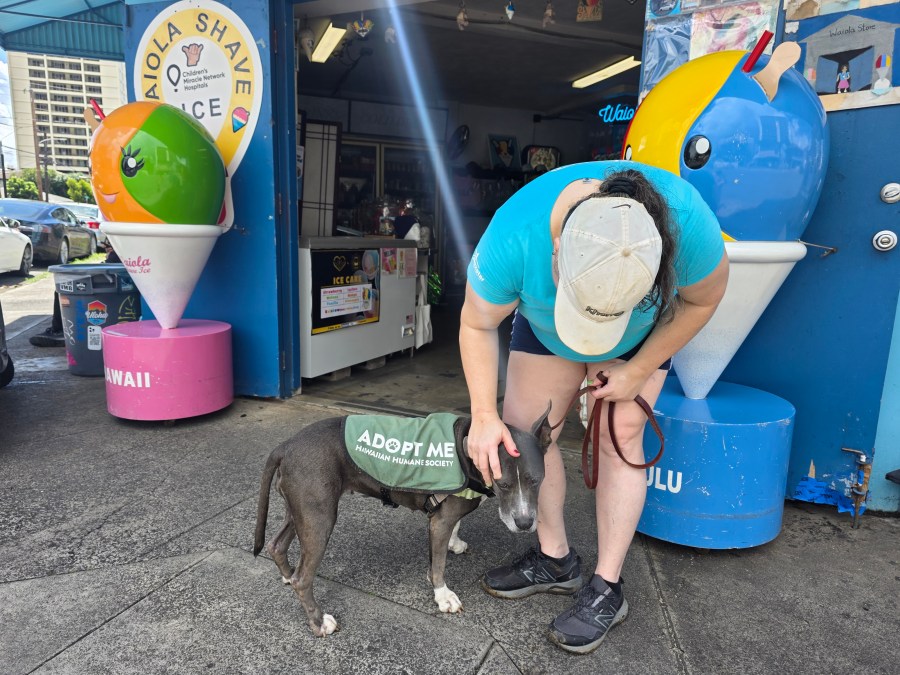HONOLULU (KHON2) — There are an abundance of canines living in Hawaii. And with so many dogs, there are some that end up in very bad situations.
On Monday, Sept. 15, KHON2.com was talking to Captain Adrian Cravalho with the Honolulu Fire Department. They were previewing the training processes for HFD personnel who risk their lives to rescue hikers, surfers, swimmers and everyone in-between.
Capt. Cravalho said that his very first rescue when he joined HFD was a dog who had been taken on a hike and had to be airlifted off the trail because the dog had overheated. Unfortunately, the dog died.
He expressed the need for people who are taking their dogs on hikes to be mindful of their health and safety.
“Dogs love you and will do whatever they think they need to do to make you happy. That includes continuing a hike when they are overheated, exhausted or injured,” explained Brandy Shimabukuro, communications manager for the Hawaiian Humane Society. “So, you really have to pay attention to what your dog is telling you.”
Capt. Cravalho said that if you’re taking your dog on a hike, then you need to understand these important factors:
- The hike needs to have shade.
- Take plenty of water for both you and your dog.
- Ensure the path is not covered in rocks or asphalt since these can cut and/or burn your dog’s sensitive paw pads.
- Listen to what your dog is telling you.
In order to understand this better, KHON2.com’s Unfit Adventurer decided to join HHS’s ʻĪlio Explorers program so that we could get a better understanding of how dogs communicate when they are in distress.
The program allows people (residents and visitors) to take dogs out on hikes, walks and trips to cafes. For our adventure, we were paired with Aliʻi Kai, one of the sweetest dogs in existence, to hike Mānoa Falls.

Here’s how to read your dog’s body language
When you are reading your dog’s body language, T-E-M-P is your guide: Tail, ears, mouth and posture. These aspects of your dog’s behavior will tell you everything you need to know.
Positive feedback
1. Relaxed (down): A dog with its tail down and body loose feels calm and content. This is the best time to hike, rest or offer gentle praise.
2. Relaxed: Soft eyes, a slightly open mouth and steady breathing mean your dog feels secure in the environment. Keep walking together and enjoy the moment.
3. Submissive/happy: I’m not a threat: A dog rolling slightly to the side or lowering its body is showing trust. Speak softly and let them come to you on their own.
4. Happy: A wagging tail held mid-height and a bright expression show excitement. Let your dog explore and celebrate this shared adventure.
5. Ready to play: A playful bow, with front legs lowered and tail up, means it’s game time. Take a break and toss a stick or let them romp safely.
6. Submissive deferential: Head lowered, tail tucked slightly means your dog accepts your lead. Move calmly and reward the behavior with kind words.
Negative feedback: When you see these behaviors, help your dog
7. Please leave me alone: A turned head or averted eyes say your dog needs space. Step back and allow them to settle.
8. Anxious stressed: Pacing, yawning or lip-licking show tension. Offer water, speak calmly and avoid pushing forward too fast.
9. Terrified: A trembling or crouched dog feels unsafe. Pause, kneel quietly and let them regain trust.
10. Fearful ready to fight: Raised hackles and a stiff tail show fear with defensive energy. Do not reach out—create distance.
11. Alert: Ears forward, eyes sharp and tail level mean your dog senses something. Stay observant and guide their focus.
12. Wary/unsure suspicious: Slow movements and hesitant steps signal uncertainty. Reassure with calm tones and steady presence.
13. Stalking: Body low, eyes fixed, tail straight means your dog is tracking. Keep control of the leash and redirect attention.
14. Defensive territorial: A rigid body and deep stance mark guarding behavior. Maintain distance from others until calm returns.
15. Angry ready to fight: Bared teeth, growls and forward posture mean aggression. End the hike quietly and give your dog space to cool down.

Have safe hikes and enjoy the love of the canine in your life!
